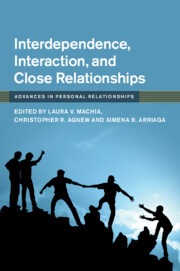Book contents
- Interdependence, Interaction, and Close Relationships
- Advances in Personal Relationships
- Interdependence, Interaction, and Close Relationships
- Copyright page
- Contents
- Figures
- Tables
- Contributors
- Acknowledgments
- Introduction
- Part I Interdependence, Situations, and Context
- Part II Interdependence, Security, and Risk
- Part III Interdependence, Goal Pursuit, and Person Factors
- 9 Autonomous Interdependence
- 10 Pursuing Interpersonal Value
- 11 Advances in Self-Expansion
- 12 Self-Esteem, Negative Expressivity, and Partner Responsiveness
- Part IV Interdependence, Timing, and Expectations
- Index
- References
12 - Self-Esteem, Negative Expressivity, and Partner Responsiveness
from Part III - Interdependence, Goal Pursuit, and Person Factors
Published online by Cambridge University Press: 19 June 2020
- Interdependence, Interaction, and Close Relationships
- Advances in Personal Relationships
- Interdependence, Interaction, and Close Relationships
- Copyright page
- Contents
- Figures
- Tables
- Contributors
- Acknowledgments
- Introduction
- Part I Interdependence, Situations, and Context
- Part II Interdependence, Security, and Risk
- Part III Interdependence, Goal Pursuit, and Person Factors
- 9 Autonomous Interdependence
- 10 Pursuing Interpersonal Value
- 11 Advances in Self-Expansion
- 12 Self-Esteem, Negative Expressivity, and Partner Responsiveness
- Part IV Interdependence, Timing, and Expectations
- Index
- References
Summary
People with low self-esteem perceive their partner’s are less responsive to their needs. A widespread assumption in the literature has been that these perceptions are “all in their heads” – a projection of their own insecurities – and that their partners are actually just as responsive as are partners of people with high self-esteem. Contrary to this assumption, however, we describe research demonstrating that, in specific interactions, people with low self-esteem's partners are indeed less responsive to disclosers’ negative self-disclosures. We review evidence for the role of self-esteem in global and specific perceptions of responsiveness and actual received partner responsiveness, discuss reasons for such findings, and suggest future work to untangle mechanisms accounting for people with low self-esteems’ lower received responsiveness. We end by discussing implications for close relationships.
Keywords
Information
- Type
- Chapter
- Information
- Interdependence, Interaction, and Close Relationships , pp. 246 - 266Publisher: Cambridge University PressPrint publication year: 2020
References
Accessibility standard: Unknown
Why this information is here
This section outlines the accessibility features of this content - including support for screen readers, full keyboard navigation and high-contrast display options. This may not be relevant for you.Accessibility Information
- 1
- Cited by
